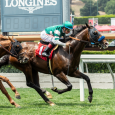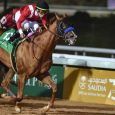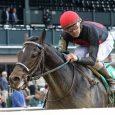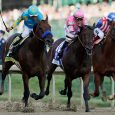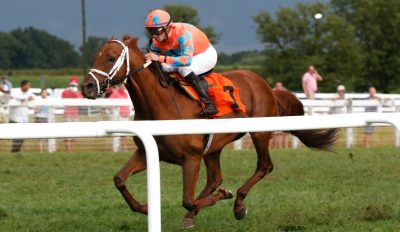
Da Big Hoss winning the Kentucky Turf Cup (photo via Kentucky Downs).
Blink and you’ll miss it! High stakes turf racing is back at Kentucky Downs to begin the month of September, but you’ll have only five racing days over the course of two weeks to get in on the racing and wagering at the turf-only oasis located within shouting distance of the Kentucky-Tennessee border, not far from Nashville.
Kentucky Downs is home to a 1 5/16-mile turf course featuring a non-oval shape and undulating terrain. With subtle elevation changes throughout the course, a sweeping turn into the stretch run, and a quarter-mile dash from the end of the final turn to the finish line, racing at Kentucky Downs is on a class all its own.
The 2018 Kentucky Downs meet consists of five dates — Sept. 1, Sept. 6, Sept. 8, Sept. 9 and Sept. 13. Expect big fields for all of the five days. A total of 190 horses were entered for Saturday’s 10-race card, including a 2-year-old filly maiden race that attracted 53 entries. (A maximum of 12 horses can start in a race.)
At just five days each September, the Kentucky Downs race meet is short, but sweet. The meet features $10 million in purses, with a nation-leading average of $2 million in purses per day. The all-turf track will host fourteen stakes races, including four graded stakes — the $750,000 Kentucky Turf Cup (G3), $500,000 Ladies Turf Stakes (G3), $500,000 Turf Sprint Stakes (G3) and the $450,000 Ladies Turf Sprint Stakes (G3). All 13 existing stakes races got purse increases this season.
The newly added stakes race at the meet will be the $500,000 (including $250,000 KTDF funds) Kentucky Downs Juvenile Turf Sprint on Sept. 8. The race is to be run at 6 ½ furlongs and it is meant to serve as a prep for the new $1 million Breeders’ Cup Juvenile Turf Sprint.
High Purses Draw Big Fields
The gigantic purse money up for grabs at Kentucky Downs is available, in large part, because of the track’s popular Historical Horse Racing terminals, which are pari-mutuel electronic games based on the results of previously run races. It’s because of the money from Historic Horse Racing, which goes toward purses, that allows Kentucky Downs to offer the rich purses it does. Kentucky Downs also is able to help fund purses at other Kentucky tracks. This year they’ve transferred $500,000 apiece to the purse accounts at Keeneland, Ellis Park and Churchill Downs.
While a significant portion of the daily purse distribution goes to the $4 million stakes program, the overnight purse structure is still high at all levels. Maiden special weights run for $130,000 purses (including KTDF money), and allowance races run for either $140,000 or $145,000. Bottom maiden races still offer $24,000 purses and bottom claiming races run for a $28,000 purse.
With purses like that, it is no wonder Kentucky Downs boasts one of the highest average field sizes in the country. In 50 races run at the 2017 KD meet, 522 horses ran — an average of 10.44 starters per race. The average field size was even higher in 2016 with an average field size of 10.96.
Low Takeouts at Kentucky Downs
Another factor in the success of Kentucky Downs is the track’s takeout rate, which is low in all pools. The biggest draw for horseplayers is the country’s lowest exacta takeout of 18.25 percent. This is not to mention a low 16 percent win, place and show takeout and 19 percent takeouts on nearly every other bet (trifecta, superfecta, daily double, pick-3, super hi-5, pick-6).
The pick-4 and pick-5 have only 14 percent takeouts. These low, player-friendly takeouts have earned Kentucky Downs the No. 1 rating from HANA, the Horseplayers Association of North America. Kentucky Downs also offers a “Jockey 7” wager, where you can bet win, place, show, exactas, and trifectas on the jockeys whose mounts you think will do the best in the day’s selected races. A portion of the track’s takeout from the wager goes to the Permanently Disabled Jockeys Fund (PDJF).
Kentucky Downs Attracts Top Horsemen
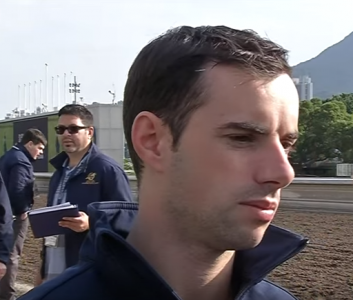
Florent Geroux
Julien Leparoux, winner of the Kentucky Downs riding title in 2014 and 2017, will ride all five days of Kentucky Downs 2018 meet. Leparoux rode six winners last season, including a four-win day on the second day of the meet. Florent Geroux and Leparoux shared the riding title in 2016, and Geroux will also be returning to ride this season as well. Another jockey who has done well at KD in the past is James Graham, so watch for his horses, as well as those of SoCal standout Flavien Prat, who is expected to ride at Kentucky Downs at least part-time. Sophie Doyle, who has enjoyed a break-out summer at Arlington where she is the third-leading rider, should be in town to ride at least a couple days of the meet.
The meet training title is likely to be dominated by Mike Maker, who is the Kentucky Downs all-time leading trainer and winner of three straight trainer titles. He’ll probably enter the most horses, too. He has five horses entered on opening day. Maker won eight races in each of the past two seasons at Kentucky Downs, including four stakes wins in 2017. One of the reasons Maker rules Kentucky Downs is that he trains for the Kentucky Downs all-time leading owners, Ken and Sarah Ramsey. The Ramseys have won six KD owners titles in a row and eight overall.
Other trainers to watch at Kentucky Downs include Ian Wilkes, Bill Mott, Tom Proctor, Ian Wilkes and Joe Sharp.
Kentucky Downs’ Winning Track Profile
Turf horses migrate to Kentucky Downs from all over the country and all over the world, but where do most of the Kentucky Downs winners invade from? It should be no surprise to handicappers that the most KD winners in 2017 had last raced at Saratoga. The next-best place to look for KD winners is with horses shipping from Ellis Park (11 winners in 2017). Arlington horses also do well at Kentucky Downs, with seven invaders winning in 2017. Other tracks that produce next-out Kentucky Downs winners include Indiana Grand, Delaware and Del Mar.
The horses arriving from those tracks tend to do better than the shippers from Gulfstream Park, Monmouth, Woodbine, Mountaineer and Europe/England. By the way, if you were wondering, Kentucky Downs is not a haven for winning first-time starters. A total of only three races have been won by first-time starters the last two years with two wins in 2017 and one win in 2016.
Due in large part of the field sizes, you can also expect large mutuel payoffs, because the two almost always go hand-in-hand. The national average of winning favorites always hovers around 30-33 percent, but at Kentucky Downs it is only 26 percent. On the other hand, however, you don’t always want to shoot for the stars when betting Kentucky Downs longshots, either. That’s because roughly 65-70 percent of Kentucky Downs races are won by one of the first four favorites.
In terms of winning running styles and post positons, it should be noted that no horse won a one-turn race (up to and including 1 mile & 70 yards) from 41 starters at the 2017 Kentucky Downs meet. There really is no other post positon bias to note since winners come from all posts all the way out to post 12 with regularity.
The biases in terms of posts and running style at Kentucky Downs seem to have the most to do with the course condition — whether it is firm or less-than-firm turf. Early speed can sometimes hold on very well at Kentucky Downs, but that is much more likely to happen from the inside six post positions and on firm turf. At other times, the races are more likely to be won by stalkers or closers that come from several lengths off the pace at the first call.
Based on the past couple years, the course condition has had most impact on which part of the starting gate is the best place to break from. When the track is anything other than firm, horses breaking from the six outside posts tend to win far more than horses starting from the inside six post positions. On firm turf on the other hand, horses breaking from the six inside posts tend to win twice as much as horses that break from the six outside posts.
Therefore, if there is one thing to keep repeating to yourself over and over again when betting Kentucky Downs’ one-turn races (up to and including 1 mile & 70 yards) it is this: Bet the inside posts on firm turf and favor the outside posts on less-than-firm turf.
Other than that, just keep pounding away with Mike Maker / Ken and Sarah Ramsey / Kitten’s Joy-bred horses and the horses shipping in from Ellis Park and especially Saratoga. With those simple tips, you will be well on your way to having a successful turf-only wagering experience at Kentucky Downs.
The Kentucky Downs season is here — don’t blink, or else you’ll miss it.

